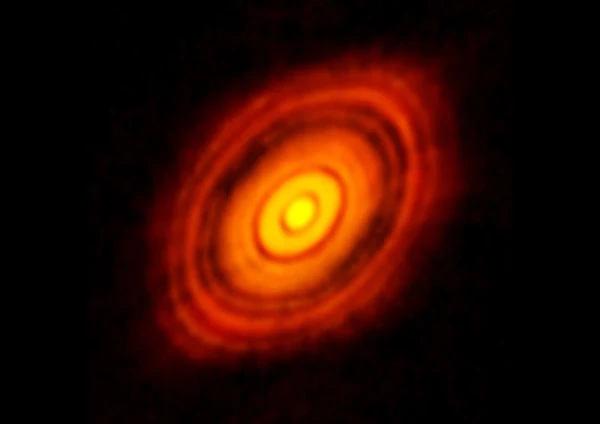
Image description: Accretion disk around a nascent star. This real image is the most precise ever made of a protoplanetary and protostellar nebula. This image was taken in millimeter waves with the NASA/ESA Hubble Space Telescope. The protoplanetary disk surrounding the young star HL Tauri (center) is clearly visible. This observation reveals the possible locations of forming planets in the dark areas at the heart of the nascent system. This image was made with the 66-antenna array of the giant ALMA radio telescope located in the Atacama Desert in northern Chile. Image source: ALMA (ESO/NAOJ/NRAO), NSF.
The Hadean is the earliest period in Earth's history, marking the end of the solar system's formation. The Hadean began approximately 4.54 billion years ago and lasted for about 700 million years.
The solar system was born from a vast cloud of gas and dust, likely triggered by the explosion of a nearby supernova. At the start of the Hadean, the protosolar nucleus had already collapsed, and our Sun, which had captured 99.86% of the nebula's mass, had been shining brightly for about 100 million years. The remaining 0.14% of the nebula, composed of the same materials as the Sun, formed a disk pushed by the solar wind, which was 100,000 times more powerful than it is today.
Dust grains in the same plane had identical velocities and easily clumped together without rebounding, forming grains of matter ranging from the size of a rock to a protoplanet. This accretion phase lasted 100,000 years.
The larger objects captured the smaller ones through gravitational force and began to establish their positions around the Sun. However, the sky was dark and still cluttered with billions of rocks of varying sizes that collided with each other. A dense disk of small planetesimals made of rock and ice extended far out, up to 35 AU from the Sun.
N.B.:
Hades, also known as Pluto in Roman mythology, is one of the principal deities of ancient Greece. He is the god of the underworld, the realm of the dead, and underground wealth.
The orbits were unstable, and objects were constantly deflected by gravitational perturbations from the larger planetesimals. In this infernal ballet, all these bodies constantly crossed paths and collided. This was the era of the Late Heavy Bombardment (LHB), during which the number of large objects decreased. Only about twenty bodies, ranging in size from the Moon to Mars, remained. These bodies now orbited in nearly circular orbits. The orbits were still traversed by bolides, and the number of very large objects continued to decrease. Thus, the accretion phenomenon led to the formation of the current planets. Among the millions of small impacts, a cataclysmic impact transformed our young Earth.
One of the objects, the size of Mars (ten times less massive than the current Earth), collided with the primitive Earth. The infernal collision tore part of the Earth's mantle without touching the core and dispersed the material into an orbit beyond the Roche limit. The gigantic heat of the impact vaporized its atmosphere, and the refractory materials retained by Earth's gravity formed the Moon.
Rapidly, within a few thousand years, a vast rocky ball covered in incandescent lava found its place in a privileged orbit not far from the Sun. A young Earth began to assert itself in this burning chaos, and its history began; we were then at the beginning of the Hadean. During the first few million years, the Earth cooled rapidly. During this cooling, a solid Earth's crust formed (about 160 million years after its formation), as well as a new atmosphere resulting from the outgassing of the fluid inner layers.
N.B.:
Terrestrial rocks dating back to the Hadean (east of Australia in the Jack Hills). Zircon extracted from a rock outcrop in 2001 testifies to this. The age of this zircon was estimated to be 4.4 billion years, only 100 million years after the formation of the Moon, 4.5 billion years ago. The Earth's crust formed about 160 million years after the formation of our planet 4.54 billion years ago.